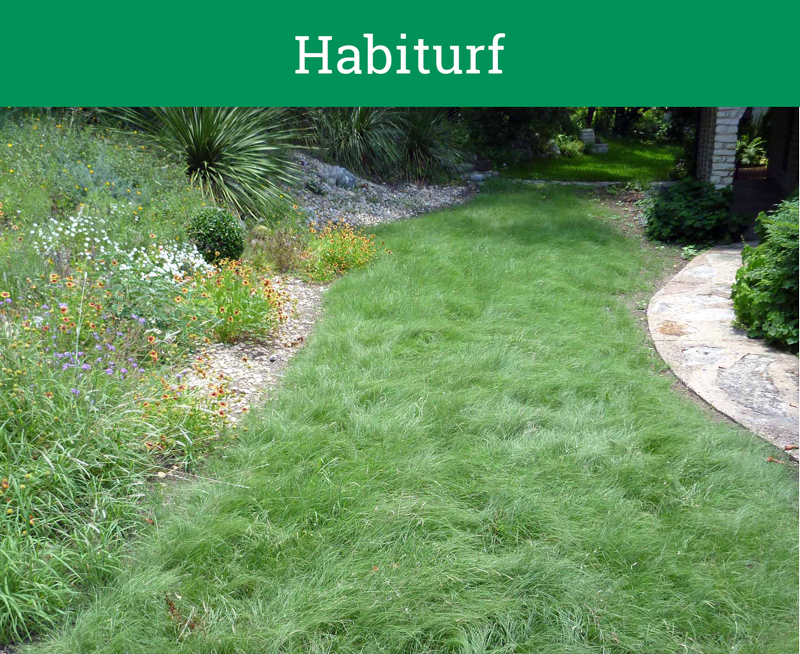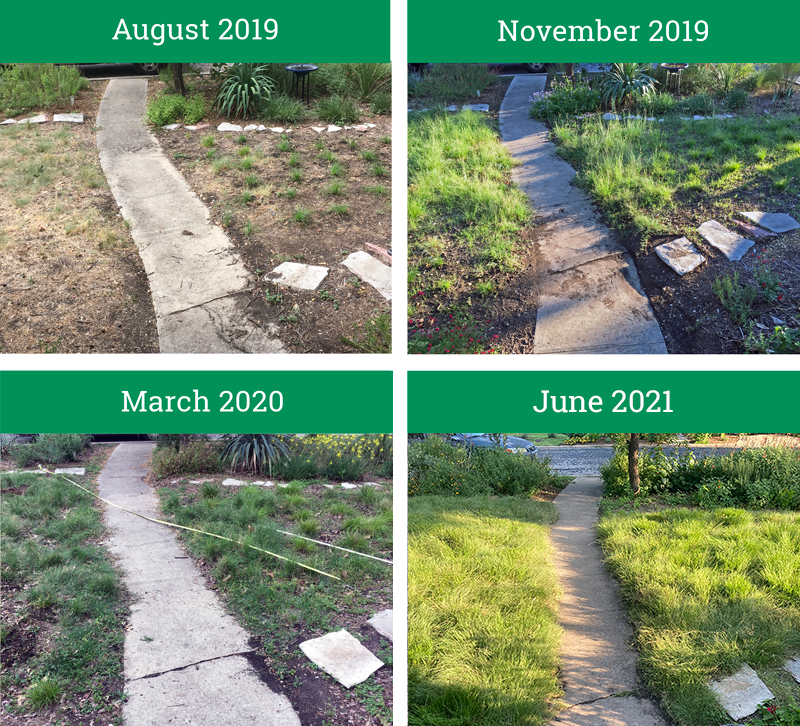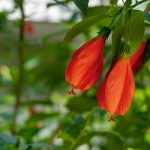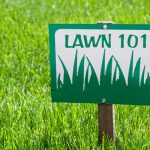In Texas, a lawn is a precious thing — not a default groundcover to be wasted on side yards and medians. But selecting the right turf type makes all the difference.
Despite all the wonderful water-saving landscape options, every now and then I yearn for a plush carpet of grass to walk barefoot on dewy mornings in spring. Of course, there are conditions to that yearning: I don’t want to have to water it; no speargrass or ouches; and I want it to look really good.
In Texas, a turf lawn is a precious thing (not a default groundcover to be wasted on side yards and medians). I think of it like a nice portrait of grandma — you want to keep a good frame all the way around her so she looks her best.
My yard isn’t a big one, so it wasn’t difficult to frame the edges of the property with shrubs and perennials. I was left with a couple of blank grass lily pads in the sunny center. I spent a couple of years mowing said lily pads before deciding it was time to take the grass up a notch.
Now I use the term grass loosely. There was some flat green stuff you could walk on when there were no ants. But when the weather got bad it turned to mud, belching up a half-century of broken glass and 1970s pop tops. Walking barefoot was out of the question. And in summer it looked hideous with 60-years-worth of random weeds, patches of St. Augustine and lascivious tentacles of Bermuda grass throughout.
So, when it came time to reprogram my now expertly edged “picture grass,” I was already saving so much water and money on the rest of the yard (and the square footage was so tiny!) that I was able to consider luxurious options like artificial turf and even St. Augustine. I even contemplated getting a sprinkler system with just two sprinkler heads to automate tiny watering sessions. But in the end, it was the lingering skeletons of withered St. Augustine and Bermuda grass (and more importantly, the price tag for 600 square feet of new turf sod) that got me to settle on the unlikeliest grass imaginable: buffalo.
I’d already seen folks using it nearby. There’s even a local product ready-made for the purpose: Texas native Habiturf, sold as seed from Douglas King Seeds out near Splashtown. (Thunder Turf is a similar product from Native American Seed in Junction.) A mix of three short greenish-blue turfgrasses (buffalo, blue grama and curly mesquite), Habiturf can be spread onto bare ground with a single bag of seed, watered in for two weeks until it sprouts, and grown into a plush carpet that would make fescue envious. The once-a-month water requirements can usually be entirely provided by rainfall even in hot summers.

So why unlikely? Well, Habiturf is typically recommended for full scorch (10 hours a day.) My place is sunny enough to kill plants, but there are also pecans and a cedar elm nearby that shade parts of the lawn when it really craves a good bake. There were competing grass weeds, and worse yet, Bermuda grass, which can swiftly overtake native grasses. And it was already October 2018, so I was already late in the grass-seed season as nighttime temperatures began pushing down towards 65 degrees. I gave the remaining grass and weeds a full kill, buzzed everything down to bare dirt, and laid down seed. And sure enough, within a couple weeks the entire lawn was glowing with emerald green stubble. I was so merry I threw in three plugs of those trendy Texas sedges from Austin, just to set up a comparison.
One of the unanticipated advantages of installing at the end of the season: the existing Bermuda grass was pretty exhausted and easily dispatched. Habiturf can’t compete with Bermuda grass, so this was a blessing; since my lawn was fully enclosed, Bermuda wouldn’t be creeping back in from next door anytime soon. By the same token, I was completely unprepared for rescuegrass.
While many SAWS customers labor every year to establish and water ryegrass in winter, in many cases rescuegrass provides the same green effect with no effort whatsoever; any child is familiar with the oat-like seed heads from schoolyards and ballfields. Looks great in winter. Sets seed copiously. Turns to dust by summer. Reappears by Halloween. Repeat. And it does this year after year with no problem. Unless you’re trying to establish a native carpet of Habiturf.
By the time I realized that my green stubble was a bumper crop of not Habiturf but well-watered rescuegrass, it was too late. I spent the winter mowing rescuegrass, and as usual it perished with the onset of summer, leaving a few sad patches of starved, beaten Habiturf that had spent the winter in its shadow.
So, I attempted a re-seeding in June. And something new happened: by August, my Habiturf had grown into a pimply teenager of a lawn with beardlike patches of bonafide native grass. By autumn there was grass everywhere, plenty of pollinators and butterflies floating around, and the pleasant billowing of leaves on windy days. It even had little grass flowers, catching compliments from a couple of passersby. It never asked for water, even in the drought of September 2019. Unfortunately, it still presented a face only a mother could love. It looked like someone had left a cake out in the rain, sweet green icing flowing down, and then hit it with a grenade. Not yet what I needed to advertise my watersaver superiority.

So here, in an emergency, came the solution: Those trendy Texas sedges were still glamping out in the middle of the lawn, having seen batches of Habiturf and rescuegrass come and go. The sedges had survived winter mowing. They’d ignored multiple rounds of grass and weed killers. They sat in full sun, were emerald green and still happy.
So I brought in a couple quick flats and underplanted the grass with a pattern of four-inch sedges: perfect green mounds, like muffins in a baking tin, and a pleasant contrast for the waving Habiturf as it faded into winter.
Year two, there is still some rescuegrass, but the oat-like seeds can be plucked out before they get ripe. The buffalo/grama/curlygrass Habiturf mix is greening up with spring, and the sedges lend a formal pattern to the entire scene that earns approving nods from passersby.
Somewhere along the way, I found myself starting to enjoy getting up early to go out and just stand there in the grass. Still weeding to be sure. But at times, there aren’t many weeds underway and it’s enough to just sample the morning, standing in the comfort of plush dewy grass … barefoot.
Join the next Conservation Gardening Series webinar Thursday, June 3 at noon when we’ll talk about turf grasses and turf alternatives. Registration is required for this free event.




